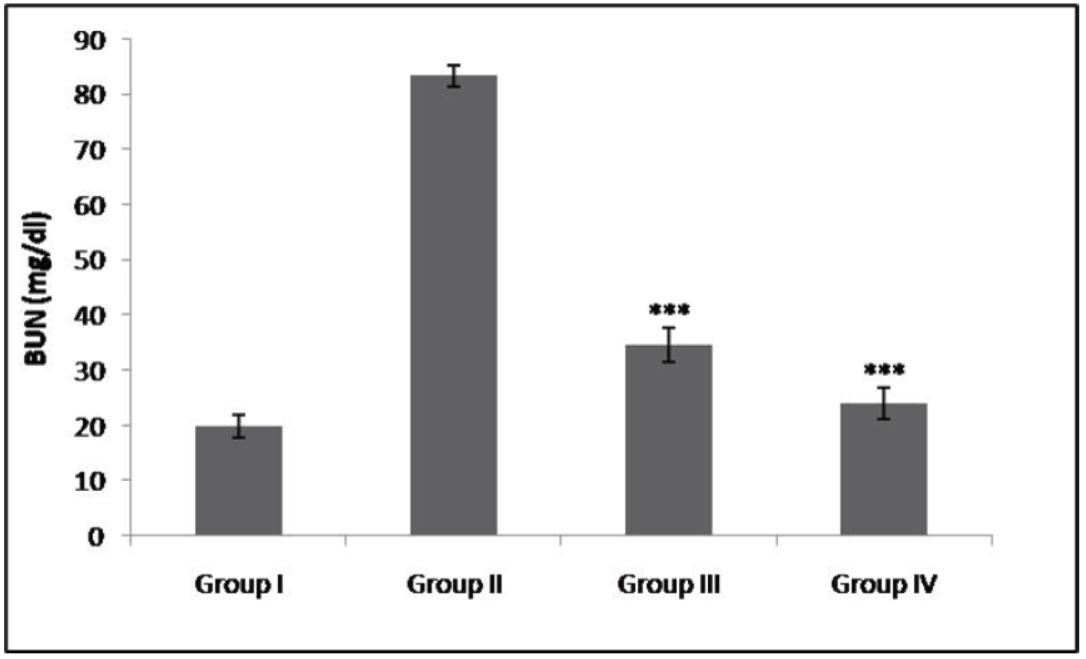Protective Effects of Tinospora cordifolia on Cyclophosphamide-induced Nephrotoxicity in Wistar Rats
DOI:
https://doi.org/10.5530/fra.2024.1.3Keywords:
Tinospora cordifolia, Nephroprotection, Cyclophosphamide, Renal function, Wistar ratsAbstract
Background: Nephrotoxicity induced by drugs is a common cause of renal failure, particularly with agents like cyclophosphamide used in cancer treatment. Natural antioxidants found in plants offer diverse therapeutic benefits. Tinospora cordifolia, a medicinal plant known for its hepatoprotective, diuretic, carminative, digestive, and anti-helminthic properties, was investigated for its potential to counter cyclophosphamide-induced kidney damage in rats. Materials and Methods: Extracts were prepared from dried Tinospora powder, rich in flavonoids, polyphenolics, and alkaloids. Rats were divided into control and treatment groups, with varying doses of the Tinospora extract alongside cyclophosphamide. The blood sample was evaluated for creatinine, urea and BUN. Results: Treatment with the extract, particularly at 400 mg/kg, significantly reduced creatinine levels, as well as serum urea and blood urea nitrogen (p<0.01). These results highlight Tinospora cordifolia's nephroprotective potential, attributed to its flavonoid and polyphenol content. Conclusion: This study underscores the promise of plant-derived compounds in mitigating drug-induced kidney damage, suggesting Tinospora cordifolia as a potential adjunct therapy to preserve renal function during chemotherapy. Further research is needed to elucidate mechanisms and validate these findings for clinical application.
Downloads
Metrics
References
Kalantar-Zadeh K, Jafar TH, Nitsch D, Neuen BL, Perkovic V. Chronic kidney disease. Lancet. 2021;398(10302):786-802.
Scholz H, Boivin FJ, Schmidt-Ott KM, Bachmann S, Eckardt KU, Scholl UI, et al. Kidney physiology and susceptibility to acute kidney injury: implications for renoprotection. Nat Rev Nephrol. 2021;17(5):335-49.
Constante-Amores CR, Kahouadji L, Williams JG, Turney BW, Shin S, Chergui J, et al. Role of kidney stones in renal pelvis flow. J Biomech Eng. 2023;145(5):51007.
Kulvichit W, Kellum JA, Srisawat N. Biomarkers in acute kidney injury. Crit Care Clin. 2021;37(2):385-98.
Bourgeois S, Houillier P. State of knowledge on ammonia handling by the kidney. Pflügers Arch J Physiol. 2024;476(4):517-31.
Kwiatkowska E, Domański L, Dziedziejko V, Kajdy A, Stefańska K, Kwiatkowski S. The mechanism of drug nephrotoxicity and the methods for preventing kidney damage. Int J Mol Sci. 2021;22(11):6109.
Sales GTM, Foresto RD. Drug-induced nephrotoxicity. Rev Assoc Med Bras. 2020;66:s82-90.
Karati D, Mahadik KR, Trivedi P, Kumar D. Alkylating agents, the road less traversed, changing anticancer therapy. Anticancer Agents Med Chem. 2022;22(8):1478-95.
Fleming RA. An overview of cyclophosphamide and ifosfamide pharmacology. Pharmacother J Hum Pharmacol Drug Ther. 1997; 17(5P2):146S-54S. 10. Iqubal A, Iqubal MK, Sharma S, Ansari MA, Najmi AK, Ali SM, et al. Molecular mechanism involved in cyclophosphamide-induced cardiotoxicity: Old drug with a new vision. Life Sci. 2019;218:112-31.
Theodoridis S, Drakou EG, Hickler T, Thines M, Nogues-Bravo D. Evaluating natural medicinal resources and their exposure to global change. Lancet Planet Heal. 2023;7(2):e155-63.
Viroli G, Kalmpourtzidou A, Cena H. Exploring Benefits and Barriers of Plant-Based Diets: Health, Environmental Impact, Food Accessibility and Acceptability. Nutrients. 2023;15(22):4723.
Yates CR, Bruno EJ, Yates MED. Tinospora Cordifolia: A review of its immunomodulatory properties. J Diet Suppl. 2022;19(2):271-85.
Arunachalam K, Yang X, San TT. Tinospora cordifolia (Willd.) Miers: Protection mechanisms and strategies against oxidative stress-related diseases. J Ethnopharmacol. 2022;283:114540.
George G, Shyni GL, Mohan S, Abraham B, Nisha P, Ranjith S, et al. In vitro and in vivo anti-inflammatory and anti-arthritic effect of Tinospora cordifolia via modulation of JAK/STAT pathway. Inflammopharmacology. 2023;31(2):1009-25.
Tolekova AN, Karamalakova YD, Nikolova GD, Georgiev TK, Gadjeva VG. Hepatoprotective effects of Tinospora cordifolia extract against bleomycin-induced toxicity in mice. Bulg Chem Commun. 2020;52:131-5.
Modi B, Kumari Shah K, Shrestha J, Shrestha P, Basnet A, Tiwari I, et al. Morphology, biological activity, chemical composition, and medicinal value of Tinospora cordifolia (willd.) miers. Adv J Chem B. 2020; 2020:36-54.
Bhakshu LMD, Yadav PR, Ratnam KV, Pandita A, Pandita D, Murthy KMS. Tinospora cordifolia (Thunb.) Miers. Potent Anticancer Med Plants. 2024;203-22.
Lami N, Kadota S, Kikuchi T. Constituents of the roots of Boerhaavia diffusa L. IV. Isolation and structure determination of boeravinones D, E, and F. Chem Pharm Bull. 1991;39(7):1863-5.
Kosaraju J, Chinni S, Roy PD, Kannan E, Antony AS, Kumar MNS. Neuroprotective effect of Tinospora cordifolia ethanol extract on 6-hydroxy dopamine induced Parkinsonism. Indian J Pharmacol. 2014;46(2):176-80.
Saad RA, EL-Bab MF, Shalaby AA. Attenuation of acute and chronic liver injury by melatonin in rats. J Taibah Univ Sci. 2013;7(2):88-96.
Helsby N, Yong M, Burns K, Findlay M, Porter D. Cyclophosphamide bioactivation pharmacogenetics in breast cancer patients. Cancer Chemother Pharmacol. 2021;88(3):533-42.
Wenqi Z, Zhuang P, Yixi C, Yi WU, Zhong M, Yongzhi LUN. “Double-Edged Sword” Effect of Reactive Oxygen Species (ROS) in Tumor Development and Carcinogenesis. Physiol Res. 2023;72(3):301.
Cengiz M, Sahinturk V, Yildiz SC, Şahin İK, Bilici N, Yaman SO, et al. Cyclophosphamide induced oxidative stress, lipid per oxidation, apoptosis and histopathological changes in rats: Protective role of boron. J Trace Elem Med Biol. 2020;62:126574.
Jha S, Vaiphei KK, Alexander A. Plant-based therapeutics: current status and future perspectives. Phytopharm Herb Drugs. 2023;3-11.
Aydin S, Bozkaya AO, MAZICIOĞLU MM, Gemalmaz A, Özçakir A, Öztürk A. What influences herbal medicine use?-prevalence and related factors. Turkish J Med Sci. 2008;38(5):455-63.
Sakihama Y, Cohen MF, Grace SC, Yamasaki H. Plant phenolic antioxidant and prooxidant activities: phenolics-induced oxidative damage mediated by metals in plants. Toxicology. 2002;177(1):67-80.
Peng R, Liu K, Li W, Yuan Y, Niu R, Zhou L, et al. Blood urea nitrogen, blood urea nitrogen to creatinine ratio and incident stroke: The Dongfeng-Tongji cohort. Atherosclerosis. 2021;333:1-8.





